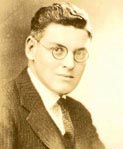
Morgan L. Combs
1929 - 1955
The only recommended candidate from the presidential nominating committee, Morgan L. Combs took office in 1929. His tenure spanned the Great Depression, World War II, and the post-war rebuilding years, bringing about a new look and a new name for the Fredericksburg State Teachers College. The metamorphosis began in 1935 when the Sate Board of Education authorized the college to offer a bachelor of arts degree, which included a foreign language requirement. Until that time, Virginia lacked a state-supported liberal arts college for women. No longer solely a teachers’ college, with new majors in history, English, foreign languages, social science, mathematics, and science, the institution changed its name to Mary Washington College in 1938, chosen to honor George Washington’s mother, who spent most of her adult life in Fredericksburg. In 1944, the institution became the liberal arts school for women of the then all-male University of Virginia.
The consolidation with UVA built upon Dr. Combs’ work to improve academic standards, raise admission requirements, and recognize a more prominent role of the faculty in the institution’s affairs. At the commencement of his presidency, only three members of the faculty held doctoral degrees, but within three years, 11 held Ph.D.’s, and all but two held master’s degrees. In addition, enrollment increased from 432 students to nearly 1,600, resulting in more rigorous admissions standards so that preference could be given to those students who ranked in the upper half of their graduating class. The campus expanded accordingly, particularly through post-war acquisitions of Framar, the residence of the president for two years that was later converted to a dormitory; Brompton, which became the official home of the president; and Trench Hill, a residence hall for academically gifted students.
However, it is the construction of new facilities that remains Dr. Combs’ major accomplishment. Improvements began with the construction of a new dining hall, named Seacobeck after an earlier Indian village located on the site, as well as the addition of four new residence halls: Ball, Custis, Madison, and Westmoreland. Like many construction projects of the time, these buildings were completed with assistance from Public Work Administration grants, which also funded the construction of George Washington Hall. Additional projects included the renovation of the Campus Training School, new entrance gates, a quaint log cabin, new facades for Chandler and Virginia Halls, and a library, named in recognition of former Governor E. Lee Trinkle’s interest in education and his support for Mary Washington. Later projects of the 1950s included the Hugh Mercer infirmary, Ann Carter Lee Hall, sister dormitories of Mason and Randolph Halls, and a fine arts center consisting of three buildings: duPont Hall, Pollard Hall, and Melchers Hall.
Because of this legacy, Dr. Combs is often remembered as “the president who built the place,” but the building process was not without its moments of erosion, particularly toward the end of his tenure. New rules for student dress and conduct were seen as overly restrictive and led to animosity between students and the administration, finally resulting in a tripartite administration of President Combs, Dean Edward Alvey, and the bursar, Edgar Woodward. In April 1955, Dr. Combs was voted out of office, a personal tragedy compounded by the revelation that he was suffering from leukemia, which factored into his death six months later.
Born on June 11, 1892, and raised on a farm in Southwest Virginia, Dr. Combs began teaching in a one-room school at age 17. He taught in public elementary and high schools in Southwest Virginia, ultimately becoming a principal, notwithstanding his lack of a college degree at the time. He went to the University of Richmond, receiving his bachelor’s degree in 1917. He subsequently earned a master’s degree from the University of Chicago, and master’s and doctoral degrees from Harvard. While pursuing formal training, Dr. Combs also gained practical experience in the field of education, serving as superintendent of schools in Buchanan County, supervisor of secondary education, and later director of research and surveys for the State Department of Education, as well as professor of secondary education at Boston University.
